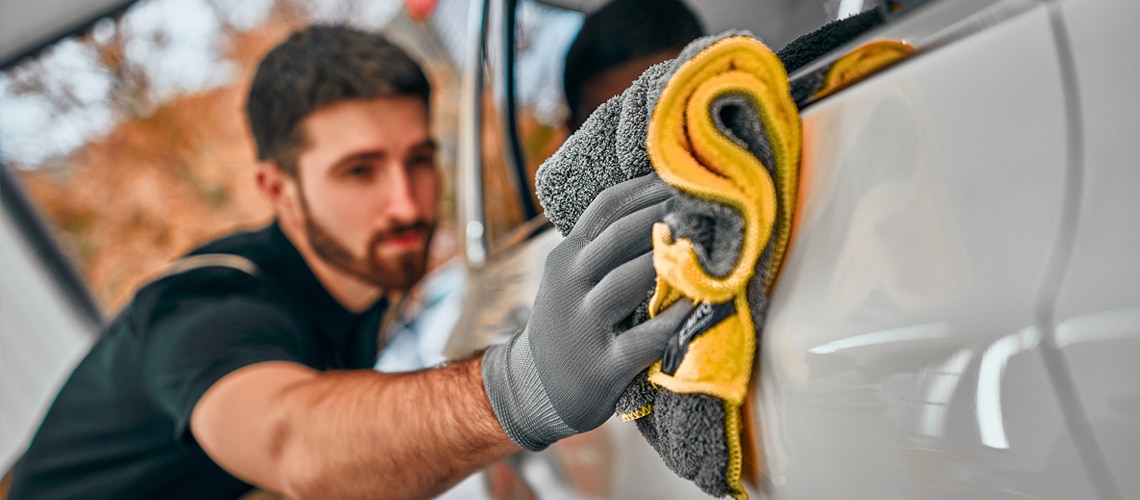(Updated for 2025)
Overspray Removal From a Car: The Modern Guide to Safe Car Paint Decontamination
It’s an instantly frustrating feeling—discovering foreign paint overspray or environmental fallout ruining the pristine finish of your vehicle. The immediate panic is understandable: Is my clear coat ruined? Does this even come off?
Before you reach for solvents or abrasive sponges, you need to know that the improper removal of contaminants will cause permanent damage. Having the right knowledge and professional-grade tools to perform paint decontamination will not only save you enormous time but will ensure the base paint and clear coat are perfectly preserved.
Continue reading for updated, critical insights on safe overspray removal and why modern detailing is an expert-only process.
The First Step: Assessing the Contaminant (Paint Type vs. Fallout)
The key to safe removal is understanding what bonded to your vehicle’s surface. This is more complex than just “paint.”
Types of Contaminants
| Contaminant Type | Composition & Risk | Modern Terminology |
| Industrial Coatings | Oil-based or epoxy paints are used for structures (bridges, tanks). These are extremely hard and require specialized chemical treatment to break down. | Aggressive Overspray |
| Acrylic/Latex Paint | Water-based and quick-drying, commonly used in residential use. While easier to remove, it can still scratch the surface if scrubbed dry. | Residential Overspray |
| Environmental Fallout | Microscopic iron dust, metal filings, or rail dust. These penetrate the clear coat and rust when exposed to moisture, causing visible pitting. | Chemical Decontamination Export to Sheets |
Crucial Update: Modern automotive finishes use highly durable, acrylic-based base coats covered by tough urethane or lacquer clear coats. The risk is less about the base paint and more about damaging the clear coat—the protective, glossy shield—with improper friction or harsh chemicals. Knowing the contaminant helps choose the exact, non-abrasive solvent needed.
Overspray Removal Methods: The Right Tool for Decontamination
Once you’ve identified the contaminant, the next step is applying the correct, gentle technique. We focus on two proven paint decontamination methods.
1. The Professional Standard: The Clay Bar (or Clay Mitt)
The clay bar is the most versatile and effective method for removing bonded surface contaminants. This elastic resin putty molds around particles on the surface, gently pulling them away when used with the right lubricant.
- Pros: Safe on all surfaces (paint, glass, chrome), non-abrasive when used correctly.
- Cons: Very slow, laborious process. Takes immense time to cover an entire vehicle, making it highly impractical for large-scale overspray.
2. Specialized Glass Cleaning: The Scraper Method
For large deposits of paint strictly on glass surfaces (windows), a specialty putty scraper paired with a correct lubricant can efficiently peel large sections of overspray.
- Warning: This method should NEVER be used on painted surfaces or clear coats, as it will instantly cause deep scratches and permanent swirl marks that require expensive paint correction.
Overspray Paint Removal Considerations (The Danger of DIY)
The process of car overspray removal must be taken seriously. Done without caution, you can cause far worse damage than the overspray itself.
- Friction is the Enemy: Even a clay bar contains micro-abrasions. Rubbing too hard or going over the same spot excessively can dull or haze your clear coat, requiring professional polishing and restoration. Once your paint is dull, there’s no quick fix.
- Lubrication is Essential: Regardless of the tool, proper lubrication is non-negotiable. The lubricant creates a buffer between the removal tool (clay) and the clear coat, ensuring the contaminant is lifted without the friction digging into the paint.
- Time and Scope: A professional-quality job requires identifying and cleaning overspray from every tiny crevice, seam, and emblem—areas that are nearly impossible to reach without specialized tools and immense patience. For someone with an entire vehicle covered, the DIY time commitment is often hundreds of hours.
DIY vs. Professionals: Protecting Your Investment
Even with the best knowledge, the probability of damaging your car while attempting removal yourself remains high.
It is always worth the time and money to consider taking your vehicle to an overspray removal professional for several key reasons:
- Hand Methods & Protection: Experts like Nationwide Overspray opt to work exclusively with meticulous hand methods, ensuring the integrity of your finish.
- Specialized Products: Professionals use high-quality, proprietary products and lubricants specifically formulated to neutralize the exact chemical emissions or coatings affecting your vehicle.
- Guaranteed Results: With decades of experience, experts waste no time in safely returning your car to its original, flawless condition, often backed by a satisfaction guarantee.
Find the Right Professional for Car Overspray Removal
Do not take your vehicle to a general auto body shop. Many of them use mechanical or aggressive chemical solutions that can embed the overspray deeper into the clear coat or cause micro-scratches.
Nationwide Overspray specializes in paint decontamination. The right professional confirms their method is non-abrasive, manufacturer-compliant, and focuses on the safe removal of bonded particles.
For more information on the professional overspray removal process, check out Nationwide Overspray’s services.

